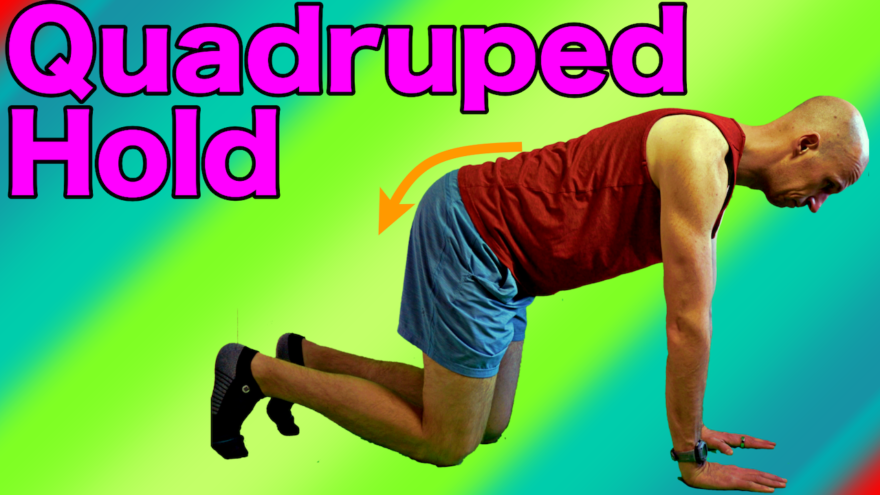Table of Contents
An important drill that will improve your pushups
You ever try a pushup and it just…looks…AWFUL? I’m talking head dipping forward, sagging like crazy, and shoulder blades looking like you might be able to fly kinda pushups?
It may be that practicing pushups more IS NOT the answer.
It could be that you or your supreme clientele have movement restrictions that prevent boss-status pushups from happening. Limitations that stretching simply won’t fix.
Or perhaps there are fundamental aspects that are needed for an effective pushup that were simply glossed over.
Folks, I got a drill for you that will improve mobility and teach pushup fundamentals simultaneously.
Enter the quadruped hold.
This move is essential to master before really pushing the envelope on any weight-bearing upper body exercises—pushups, bear crawls, mountain climbers, and more.
Quadruped is like learning musical scales to your Stairway to Pushup Heaven.
Let’s start class!
Check out the video and post below to learn all about this awesome move!
The biomechanics of the quadruped hold
You might be thinking, “Zac, I’m on FREAKING HANDS AND KNEES, how complicated do we have to make it?”
I get it, the quadruped hold doesn’t seem like much. But truly grasping this move’s biomechanics will both up your coaching game and give you ideas of when to best program it. Yo fam, you’ll be like a coaching triple threat. Like a Movement Michael Jordan.
But if you want to be a Bob “Biomechanics don’t matter I can only dribble with one hand” Cousy, more power to ya! 😉
First, let’s describe some of the relevant joint angles of the quadruped position:
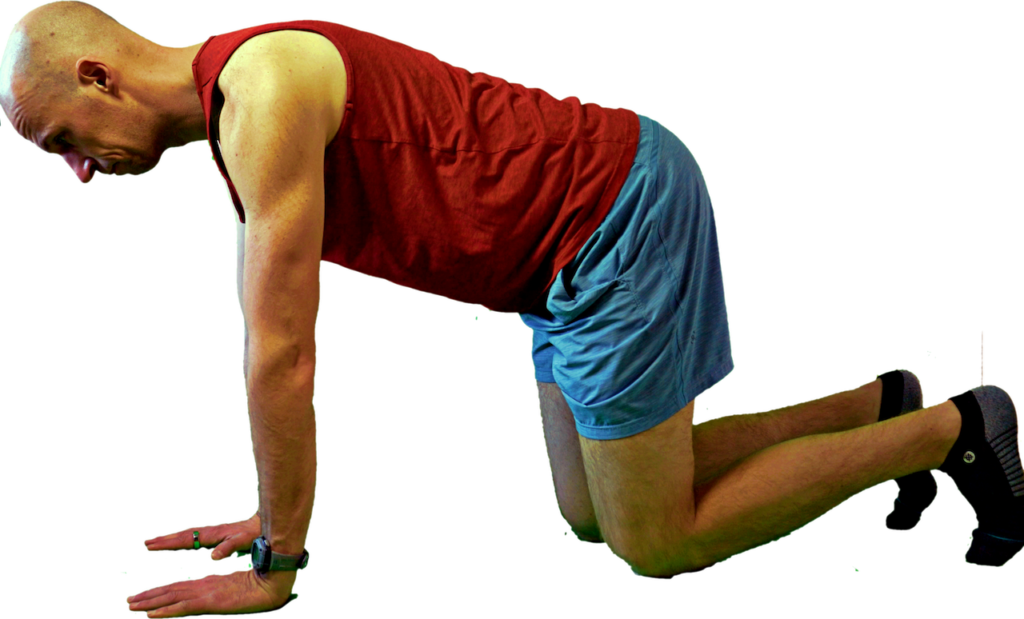
- Ankles plantarflexed
- Pelvis, thorax, and head all lined up atop one another
- Hips flexed to 90°
- Shoulders flexed to 90°
- Upper cervical extended
Based on their respective biomechanics, both hip and shoulder flexion at this specific angle produce internal rotation positions within each joint.
Because we will be coaching breathing during this activity, the oscillating airflow and visceral movement that accompanies breathing in this position will promote anterior pelvis expansion as well as the ribcage pumphandle action, especially if we keep the ventral cavity (thorax, abdomen, and pelvis) lined up as I mentioned above. If we are expanding these areas, we will increase the available range of motion (space) that the position dictates.
Therefore, expanding in the quadruped position will promote increased internal rotation range of motion in the upper and lower quadrant.
Moreover, according to this article, the supine position will promote increased lateral ribcage dimensions. Since quadruped interacts with gravity in a similar manner to the supine position, it would seem to be the lateral ribcage expansion would also be promoted by this activity.
Assessment findings that warrant programming the quadruped hold
If you have someone who needs internal rotation, then the quadruped hold is an excellent move to choose.
Objectively, the following assessment findings may indicate programming the quadruped hold:
- Decreased shoulder internal rotation, adduction, and flexion
- Decreased hip internal rotation, adduction, and flexion
- Narrow infrasternal angle with reduced lower ribcage expansion
Now that said, going after internal rotation-based measures implies that I have authentic shoulder and hip flexion up to 90 degrees, which involves external rotation actions. An external rotation deficit may explain some of the following faults we’ll discuss later on:
- Scapular winging
- A thorax that falls too far forward
- Wrist discomfort
Where does the quadruped hold fit in the programming continuum?
The quadruped hold is one of the earliest drills in the pushup lineage, as the ventral cavity and shoulder positions mimic one another. This position is easier than a pushup for the following reasons:
- There are more body points contacting the ground
- There is less bodyweight to manage with the upper body
- Bodyweight is more evenly distributed between the upper and lower body
- We are only isometrically holding the top portion of the movement
Performing the quadruped hold
There are five total steps to performing the quadruped hold like a boss!
- Start sagged
- Slight pelvic tilt
- Reach arms long
- Untuck chin
- Breathe
Let’s now look at each step of the quadruped hold.
Start the quadruped hold sagged
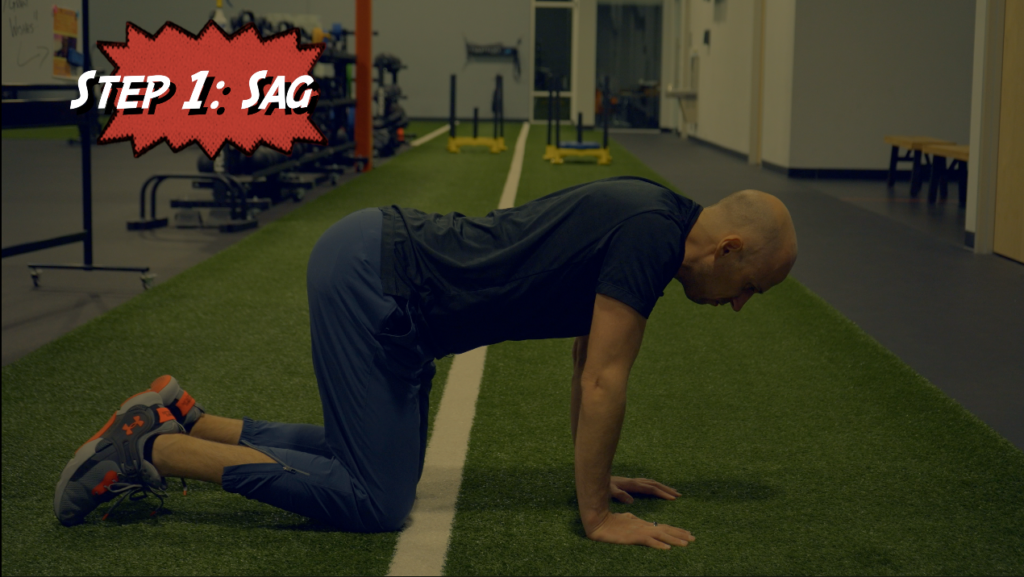
Starting the activity sagged and relaxed helps provide contrast to where the body is going in later steps.
If you are already creating a bunch of muscle activity before you even get in position, chances are you’ll create excessive muscular tension, limiting your mobility gains. Let it go like Frozen yo!
Pelvic tilt during the quadruped
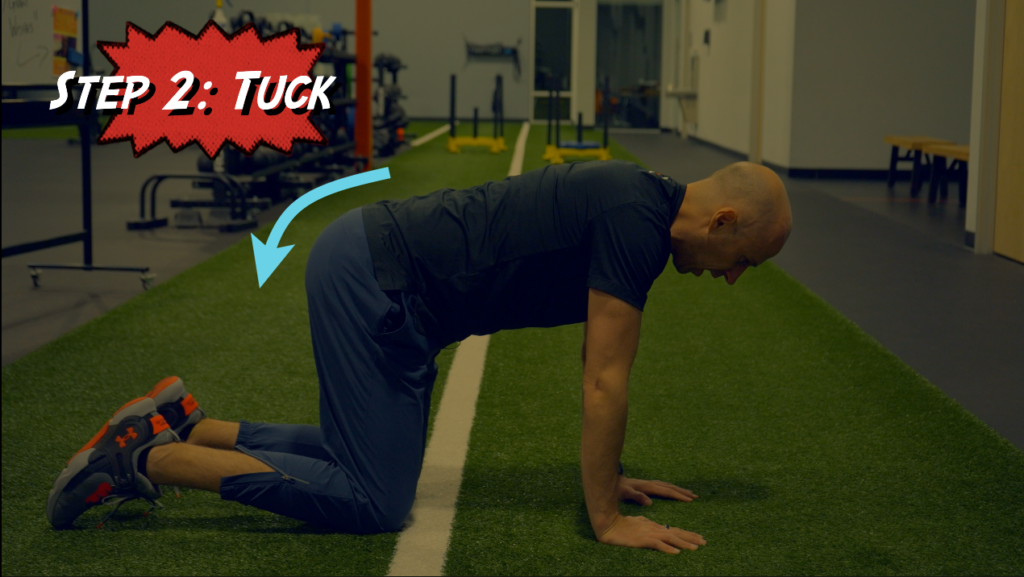
The pelvic tilt helps achieve the pelvic positioning discussed in the biomechanics section, helping maximize lower body range of motion gains.
I will generally cue an effective tilt one of three ways (maybe even all three if I’m feeling frisky):
- Back pockets to heels
- Tailbone long
- Press kneecaps into the ground
Common pelvic tilting errors
There are two common faults that occur with the pelvic tilt.
The first is staying sagged. This fault creates an anterior pelvic tilt, which will limit any motion gains you were hoping for with this move.
Solution: Cue the pelvic tilt as described above.
The second fault is someone who overtucks, creating a turtle shell-like appearance as they tuck.
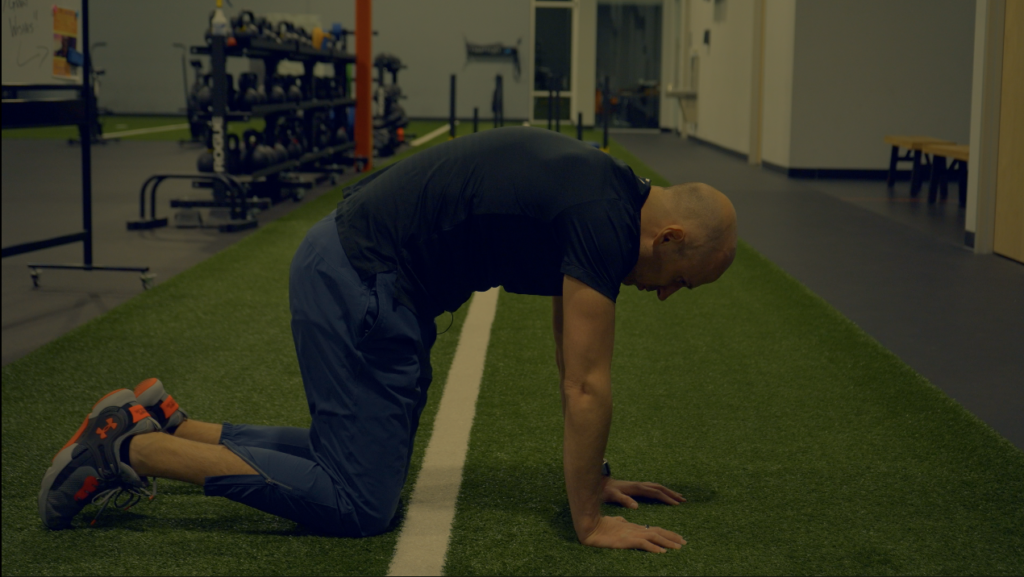
This fault is merely spinal motion. Which guess what big fam? If you are moving through your back, your pelvic mobility gains will be whack. You aren’t creating any relative motion change at the pelvis.
Moreover, this fault often accompanies a depressed sternum, which can imact any upper thorax range of motion gains you were hoping for.
Solution: Coach the tuck SUPER subtle. Or if that fails, use the knee cap drive cue, but GENTLE, fam.
Reaching arms long during the quadruped hold
Reaching well is essential for increasing thorax mobility with this activity.
To perform an effective reach, I want four things to happen:

- Push through the pisiform bone (the wiggly bone on your wrist; opposite of the thumb)
- Keep chest parallel to the ground
- Reach your arms long, slow, and fully
- Unflare the elbows/point elbows towards thighs
Common reaching errors
The reaching portion is where most of the screwups will there. OMG THERE ARE SO MANY!
But don’t worry, Big Z has you covered!
The first error I see is the overzealous reacher. This person tries to whip their body FAST into position, trying to sneak past your coaching eyes.
Boy did they not see you coming!
The problem with this fault is that when you move fast in general, muscle activity has to increase. Too much muscle activity means less available range of motion. Less motion means you ain’t getting any mobility gains, fam!
Solution: Double down on reaching slow.
The next fault you may see is the turtle shell.
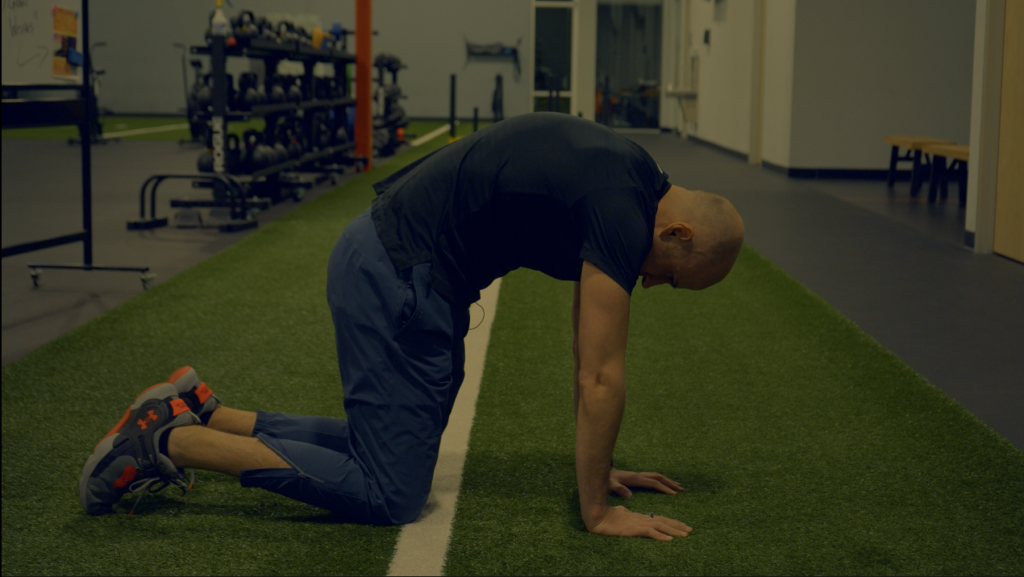
We saw this fault with overtucking the pelvis, as they are often paired. This reach orients the thorax anteriorly. The increased pec and rectus abdominis activity you get from this action will limit anterior thorax expansion.
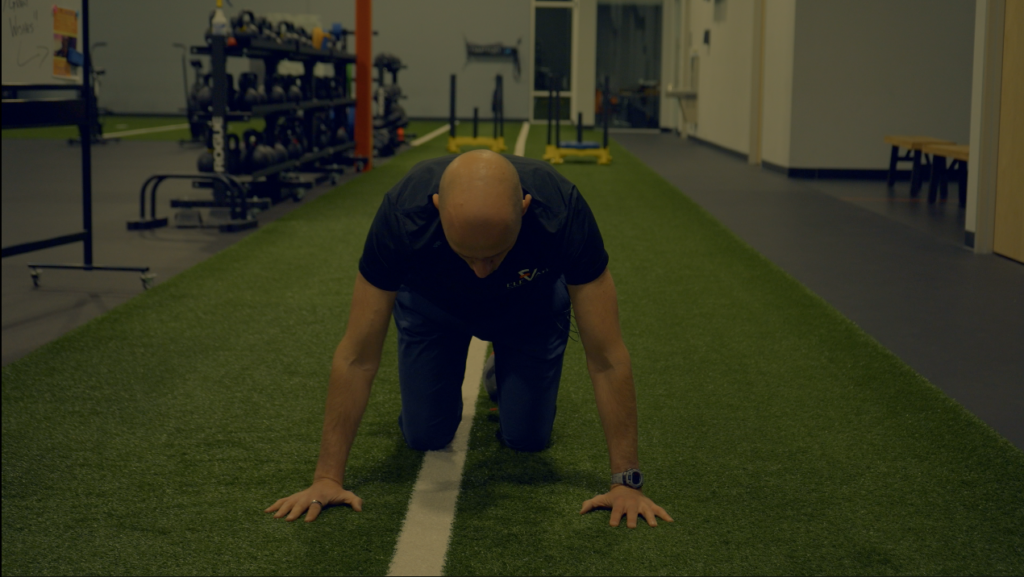
Solution: Encourage chest parallel or try a wider stance with the arms. If these tactics fail, try some of the other variations shown later in this post.
The last fault you’ll see is the sagger. This person has the shoulder blades dangling in the air, with the upper back sitting WAY forward.
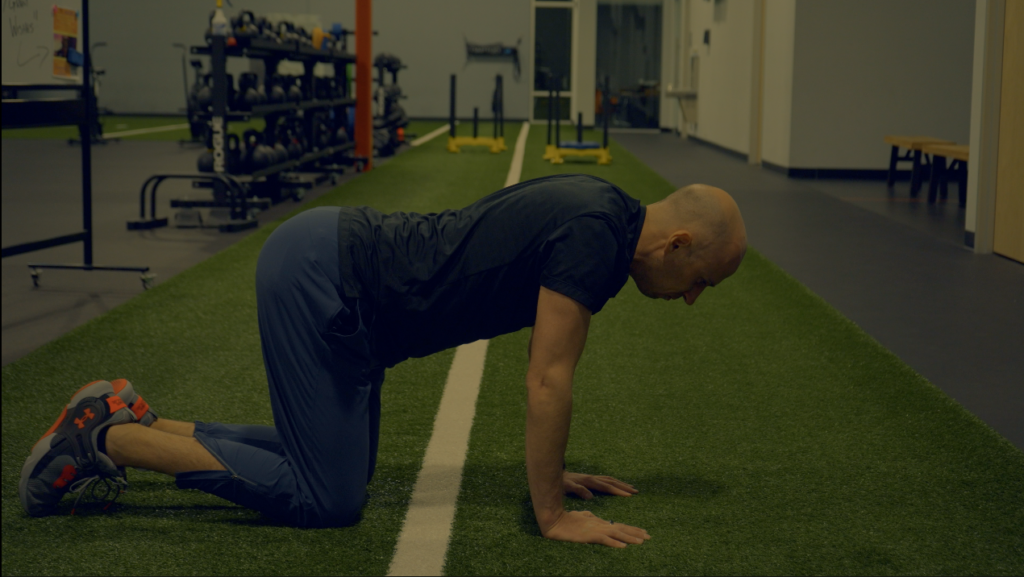
The problem with this fault is that if the thorax is WAY forward, then there is increased muscle activity in the upper back, meaning you won’t get a whole lotta range of motion gains in that area.
Solution: Provide a manual cue on the upper back or assist into position. If these tactics fail, try some of the other variations shown later in this post.
Untuck chin during the quadruped hold
Keeping a good neck position ensures your neck stays relaxed and you maximize airflow.
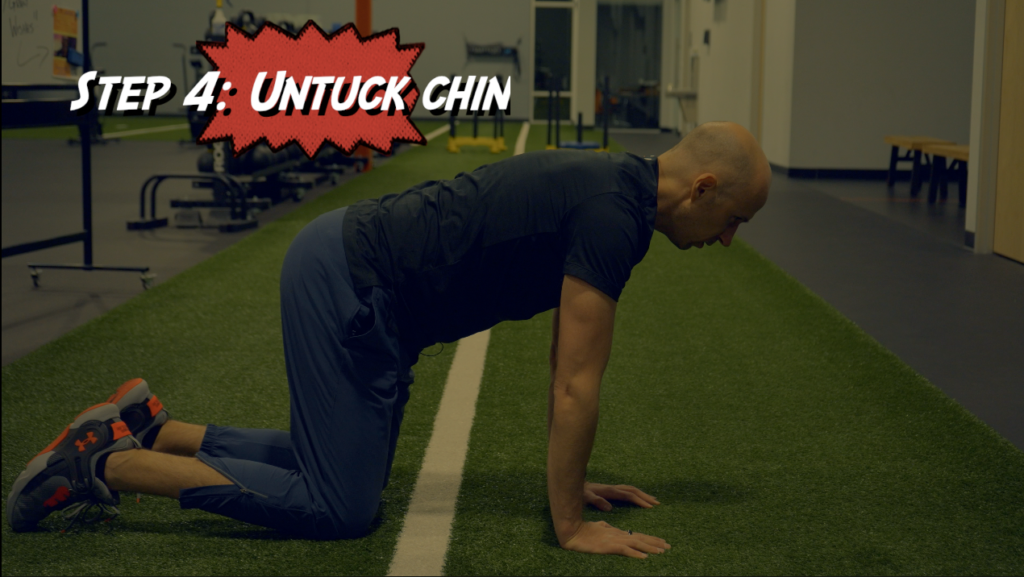
The two big cues that I use here are:
- Chin away from neck (untuck chin)
- Eyes looking toward the horizon
Common neck errors
Upper cervical flexion is the most common error we will see with this movement. You don’t want to tuck your chin, as that’ll 1) close off the airway, limiting expansion, and 2) create upper thorax muscle activity down to T5, limiting expansion in that region.
Solution: Undouble chin yourself
Breathing during the quadruped hold
A low effort breathing sequence is critical for encouraging segmental ribcage motion, which will maximize the shoulder mobility improvements that can occur with this activity.
Here are the steps to an effective breathing sequence:
- Silent through the nose
- Full and slow exhale through the mouth
- Maintain body position described above throughout the breath cycle
Breathing errors
The most common breathing errors involve going way too fast, mouth breathing the whole time, or losing body position. If you go slow and follow the steps, you’ll crush it.
Solution: Silent inhale (no one should hear it), full exhale, hold on for dear life!
Other quadruped hold variations
If the quadruped hold is still tough, there are three variations I’ll use to enhance the effects of the position:
- Wedged quadruped hold
- Incline quadruped hold
- Offset quadruped hold
Let’s dive into each!
Wedged quadruped hold
You ever get wrist pain when you are weight bearing through your arms? Then using wedges might be in your future!
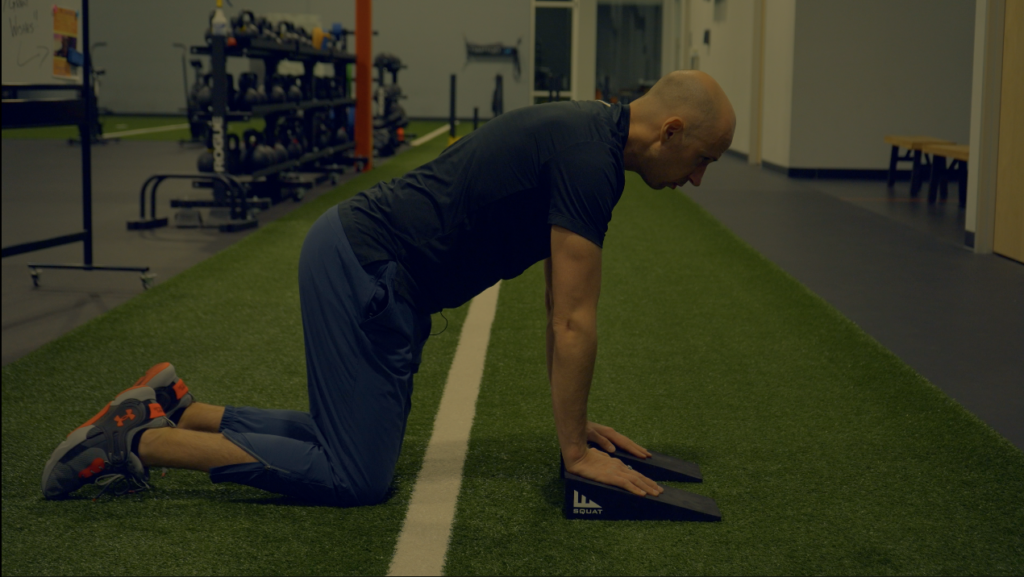
Wedges are useful because they place the wrist in a more flexed position, which reduces pressure on the back of the wrist.
Biomechanically, wrist flexion/reducing wrist extension will help create an external rotation action throughout the arm. If I have external rotation through the arm, the scapula can more easily achieve an internally rotated position (where the medial border is away from the ribcage).
If the medial border is away from the ribcage, it’s easier to push air into the upper back region. The more air I can get in the upper back, the easier it’ll be to keep my shoulder blade flush against the ribcage. This action could potentially increase both shoulder external and internal rotation. Double whammy indeed!
External rotation would increase because of the upper back position. Internal rotation could increase because my arms are at 90° of shoulder flexion.
The wedges I like to use are the Wedgiez.
Incline quadruped hold
What do you do if you have a person who can’t perform a pushup well? How do you make it easier?
Simple, you may have them do a pushup on an inclined surface, and life is good.
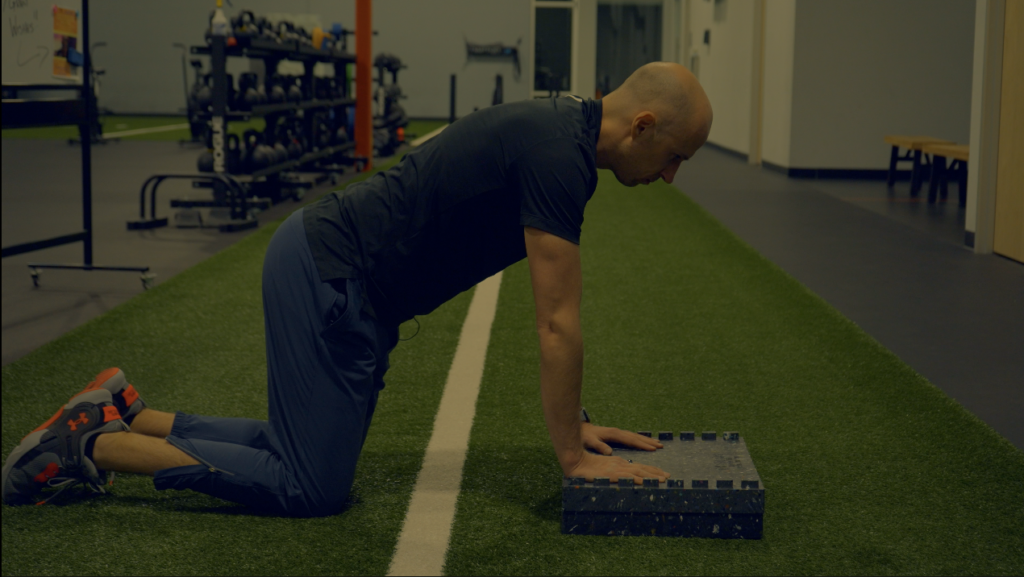
Since the quadruped hold is a precursor to the pushup, the same rules apply here. The incline reduces the loading through the arms, minimizing compensatory activity.
Offset quadruped hold
What if you have someone who is having a really difficult time getting a full reach. They may even be strong as all hell, but seemingly struggle with such a simple move.
You actually may have to up the difficulty, sort of.
Oftentimes, these folks who can’t achieve a full reach are super stiff—with multidirectional upper quadrant limitations.
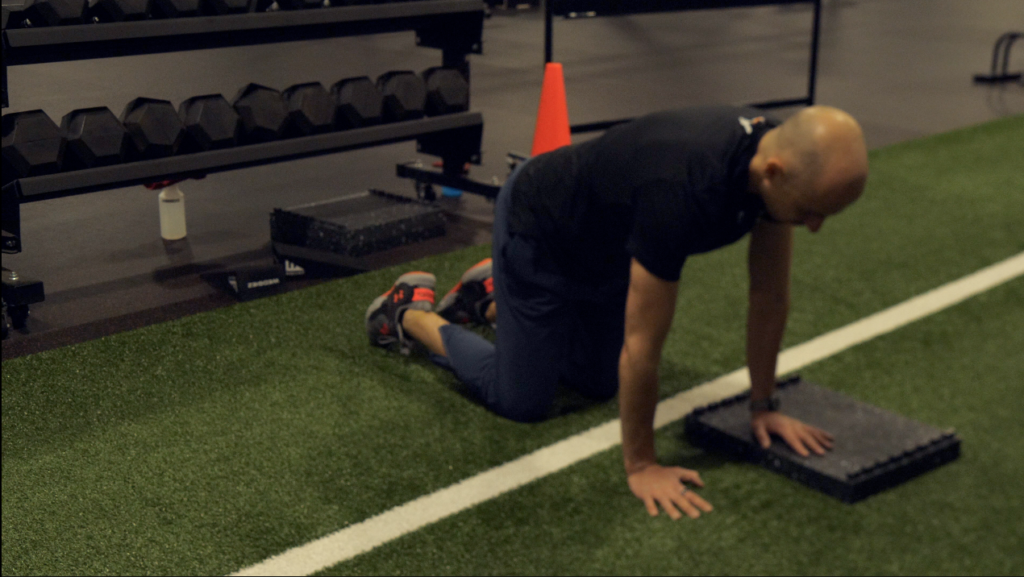
Offsetting quadruped induces a bit of rotation into the movement. When I rotate, I have the potential to increase my available movement excursion by creating a gradient. This could potentially help those super stiff folks get a better upper thorax position.
And if by some chance they need a bit of assistance during the mix, you could most definitely elevate this movement as well!
Sum up
Those are the major keys to performing the quadruped hold like a boss!
To summarize
- The quadruped hold is a precursor to any upper body weightbearing activity, especially pushups
- The quadruped hold position has an internal rotation-bias about it, and can improve mobility in this respective measure
- Performing the quadruped hold well involves a slightly tilted pelvis, full arm reach, upper cervical extension, and effective breathing
Did I miss anything? How has quadruped been a helpful drill for you? Comment below and let the fam know!
